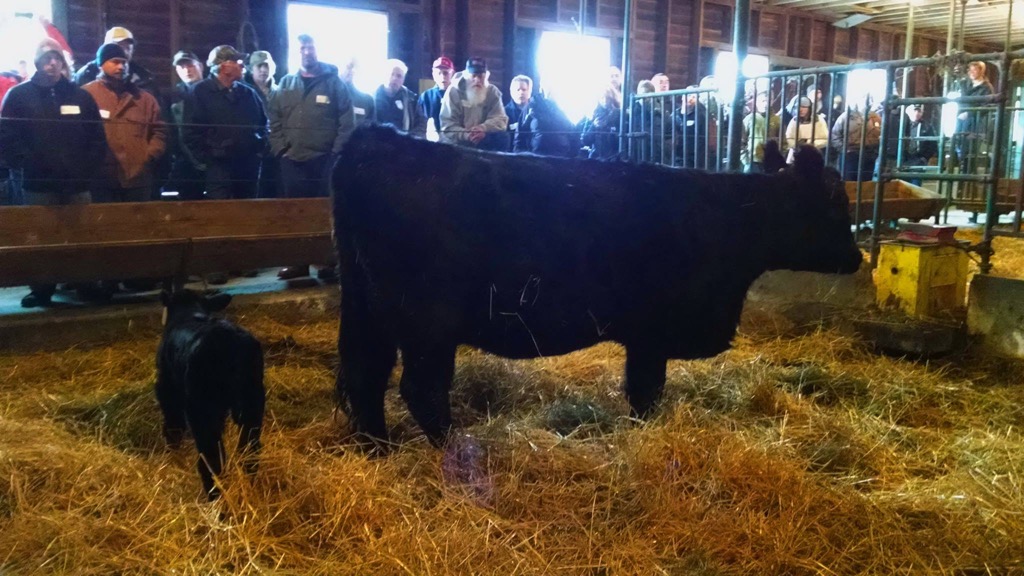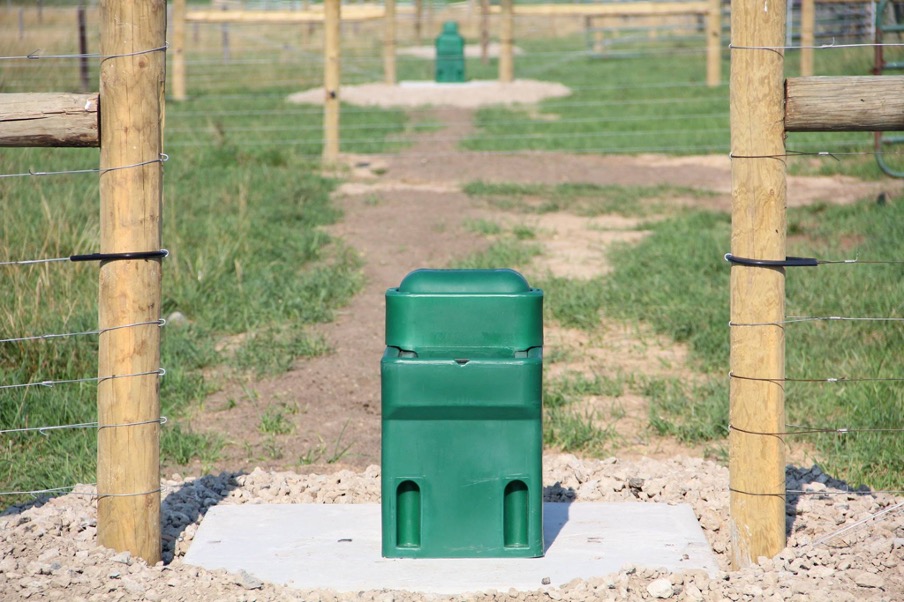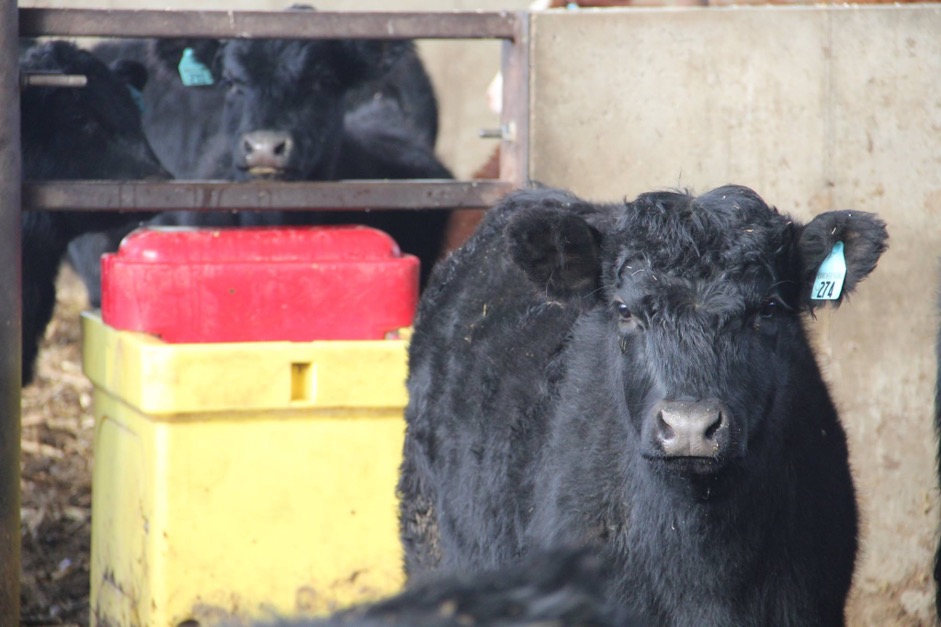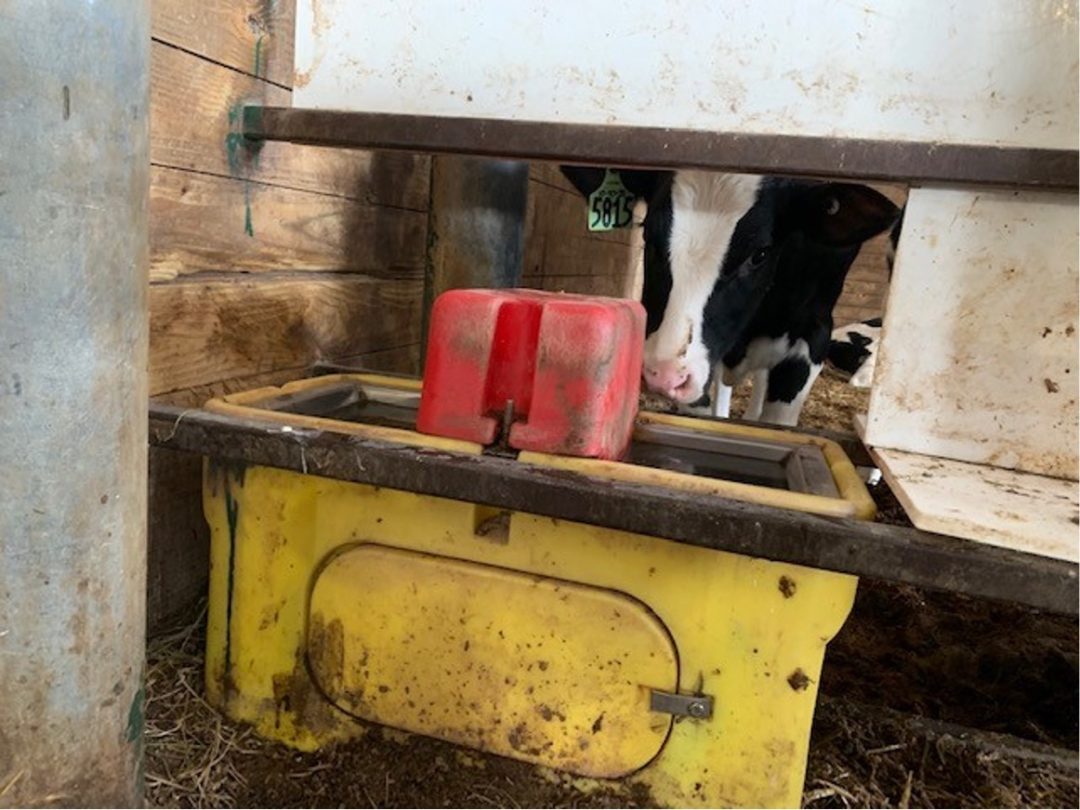Water crucial for healthy rumen development
Even though calves are on a liquid diet, offering fresh water from day one is key to developing a healthy rumen. When calves drink fresh water, the water goes into the rumen, as does starter feed. When calves drink milk, it by-passes the rumen via the esophageal groove and is deposited into the abomasum.
“The bacteria that are going to support this growing animal for the rest of her life live in the rumen,” said Faith Cullens-Nobis, Michigan State University College of Agriculture and Natural Resources South Campus Farms Director and MSU Extension Educator. “The most important thing to know is that the rumen bacteria need to live in water, not milk. Water goes into the rumen and provides the house for the bacteria to live in and kickstarts rumen development.”
Ruminal bacteria are responsible for fermenting grain and hay. Without adequate water intake, ruminal development is delayed, and calves are slow to gain weight.

Photo Credit: MSU Beef Center 2014
Access to water helps prevent scours & dehydration
Scours are the universal bane of cattle producers. Every year calf scours rank among the costliest health related issues for cow-calf operations. Scouring calves can develop dehydration, metabolic acidosis and electrolyte imbalances. There are many causes of scours including:
- Bacteria such as E. coli or Salmonella
- Viruses such as rotavirus or coronavirus
- Protozoan parasites such as Cryptosporidia or Coccidia
- Osmotic imbalance
Deacon calves that are drinking milk or milk replacer that has high total solids (over 15 percent) are at risk of creating a situation where the osmotic balance in the calf is out of equilibrium and water is pulled out of the cells resulting in scours and dehydration. Providing fresh water can help lessen this effect. The clinical signs of dehydration first occur when the fluid loss reaches five to six percent of the body weight and death occurs at a loss of 12 percent.
Increased water consumption helps at weaning
Nursing beef calves drink milk in small amounts throughout the day and learn to drink water by watching their dam. Deacon calves learn by exploring and watching other calves. Ideally, calves need waterers kept at or below 24 inches in height. Providing fresh, clean water to calves from day one sets them up for a healthy start.
“When you start the weaning process, it is so important that the calves are consuming enough water,” said Cullens-Nobis. “This is a stressful time and chances are you are putting them together in a small group of around eight, so you need to monitor the calves. If you notice one not coming up to eat, laying back from the group or developing a rough coat, then you need to find out if the calf is drinking enough water and eating grain. It is also important to take note of the social hierarchy and make sure the weaning pen has enough space for everyone around the waterer and feed bunk. Grouping calves together within similar age groups is vital because even a difference of 50 pounds in weight can be really detrimental to calf health. Smaller calves can get excluded from the feed or water.”

Photo Credit: MSU Beef Center 2016
Calves are sensitive to sodium in the water
It is recommended that producers test their water sources roughly every three years for bacteria and mineral content.
“Calves are really sensitive to sodium,” said Cullens-Nobis. “If you are using a water softener or have water that contains high levels of sodium, it can cause sodium toxicity which causes scours. The more the calf drinks the water or milk replacer mixed with the high sodium water, the worse it gets and they will eventually die from dehydration.”
Calves need water that has been tested and verified to have low sodium levels of less than 100 parts per million.
Automatic livestock waterers deliver clean, fresh water on demand
The most efficient and labor saving way to deliver water to your calves is to use an automatic livestock waterer. Automatic waterers deliver fresh, clean water on demand. Even though automatic waterers may cost more initially, the savings over time includes less water waste, less labor to clean and monitor the waterers and more peace of mind that your cattle will always have access to clean water.
According to the professionals at Valley Farms Supply in Lansing, Michigan, automatic watering systems can also be fitted to portion the water with electrolytes or liquid medications such as CORID® (amprolium) using a dosing pump that works with the water and plumbing supply.
“Automatic waterers make it a lot easier to provide consistent water, especially through the cold winters we have here in Michigan,” said Cullens-Nobis. “We have several Ritchie livestock waterers across campus and some in the dairy are really quite old. We have found that (the Ritchie) waterers are easy to repair, easy to find parts for and hold up really well. And that’s saying something because they have survived students driving skid loaders around them.”

Photo Credit: MSU Beef Center 2017
Choosing the right Ritchie Waterer for calves
Ritchie Industries was founded in 1921 by Thomas Ritchie, an Oskaloosa, Iowa farmer. Ritchie patented the first automatic waterer valve and developed the first automatic livestock watering systems. Headquartered in Conrad, Iowa, Ritchie is an employee-owned business that designs, engineers and manufactures over 40 models of waterers to meet the needs of livestock producers and horse owners.
Here is a list of Ritchie models that are perfectly suited to meet the water needs of growing calves. All Ritchie waterers come with a 10 year warranty.
| Model | Description | Drinking Height | Herd Capacity |
|---|---|---|---|
| Omni 1 | 304 Stainless steel trough with insulated poly | 18” | 20 Beef, 10 Dairy |
| Omni 2 | 304 Stainless steel trough with insulated poly | 18” | 40 Beef, 20 Dairy |
| Omni 2 - Special | Specifically designed for smaller animals | 11” |
40 Beef, 20 Dairy 100 Sheep or Goats |
| Omni Combination Conversion | Adds a lower trough to an already existing Omni 5 or 10 | 13” | 20 Beef, 10 Dairy |
| WaterMatic 100 | Compact, one piece insulated poly | 18” | 20 Beef, 10 Dairy |
| WaterMatic 150 | Compact 2 trough design ideal for fence line application | 18” | 40 Beef, 20 Dairy |
| WaterMatic 150S | Compact 2 trough insulated poly with domed cover | 13” | 40 Beef, 20 Dairy
100 Sheep or Goats |
| EcoFount 1 | Most energy efficient with flip top cover and 304 stainless steel trough | 20” | 30 Beef, 15 Dairy |
| EcoFount 2 | Most energy efficient double drink with flip top covers and 304 stainless steel trough | 20” | 60 Beef, 30 Dairy |
| Thrifty King CT 1 | Fully insulated poly with elliptical closures for easy drinking | 19” | 30 Beef |
| Thrifty King Ct 2 | Fully insulated poly with elliptical closures for easy drinking | 19” | 100 Beef |
The bottomline: Don’t overlook the importance of clean, fresh water
Get your calves off to a healthy start by offering clean, fresh water from day one. Investing in a reliable, automatic livestock waterer generates cost savings over the long term and ensures that your calves have access to water at all times and in all weather conditions.
For more information visit:
Ritchie Industries | RitchieFount.com
Michigan State University Extension | Agriculture (msu.edu)






